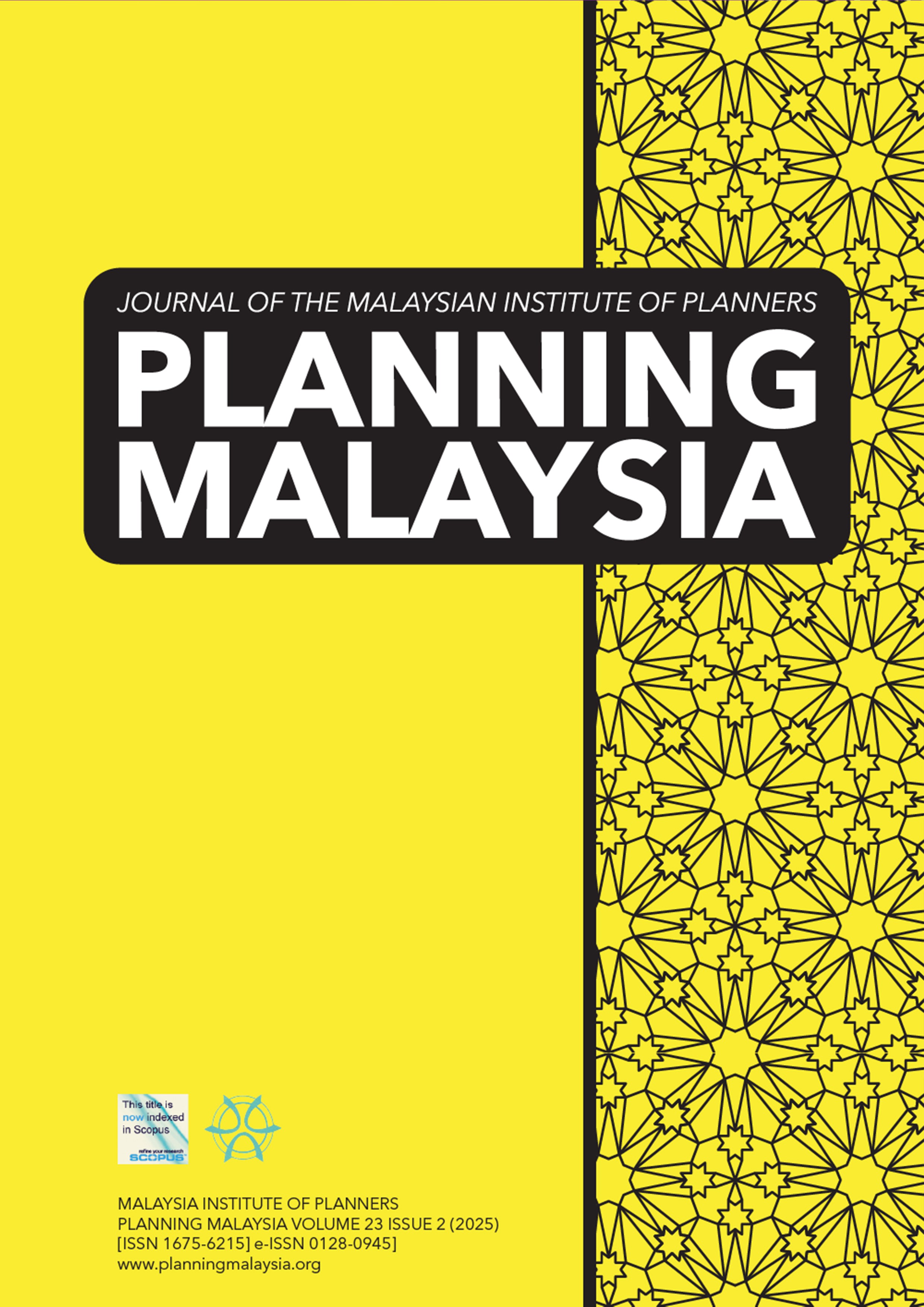AGILE URBAN SYMBIOSIS: STRATEGIC DEVELOPMENT OF HOSUR AS A RESILIENT SATELLITE CITY FOR BENGALURU, INDIA
DOI:
https://doi.org/10.21837/pm.v23i36.1727Keywords:
Transformation, Agile City, Organic Solidarity, Reimagine, ContingentAbstract
Urban environments exhibit mounting complexity, yet traditional centralized planning methodologies struggle adapting to rapid transformations. An agile approach prioritizes iterative, experimental interventions reconciling short-term necessities and long-term resilience. This paper investigates agile adaptation's potential calibrating secondary municipalities like Hosur, India into sustainable ancillary settlements for major metropoles including Bengaluru. Utilizing Durkheim's organic solidarity concept, diverse, interdependent urban collectives foster social cohesion while enabling flexibility. Through limited pilot initiatives, collaborative governance, and scenario analyses, municipal bureaucracies can nimbly confront uncertainty and evade lock-in to rigid developmental trajectories. Hosur's proximity to Bengaluru engenders opportunities for developing sustainable, habitable auxiliary urban capacity, contingent on reimagining inclusive urban design and infrastructure augmenting resilience, accessibility, and quality of life. This manifests a novel iteration of engineered organic solidarity between municipalities. Though situated in different states, the potential for a symbiotic relationship between Hosur and Bengaluru is contingent on effective intergovernmental collaboration between Tamil Nadu and Karnataka. Adopting an agile paradigm, civic governments can implement adaptive governance addressing immediate needs while expanding prospective options. This empowers equitable enhancement of resilience and sustainability.
Downloads
References
About DMA :: Tamilnadu Single window portal for planning permission. (n.d.). Retrieved from https://onlineppa.tn.gov.in/about-dma
Bengaluru Development Authority. (2024). Revised Master Plan for Bengaluru-2031 Draft: Volume 3: Master Plan Document. Government of Karnataka.
Brundtland, G. H. (1987). Our common future. The World Commission on Environment and Development.
Budiati, L. (2017). Local leadership model towards a resilient city in Semarang Municipality. Planning Malaysia: Journal of the Malaysian Institute of Planners, 15(1), 377–388. DOI: https://doi.org/10.21837/pmjournal.v15.i6.254
Burger, M. J., van der Knaap, B., & Wall, R. S. (2013). Polycentricity and the Multiplexity of Urban Networks. European Planning Studies, 22(4), 816–840. https://doi.org/10.1080/09654313.2013.771619 DOI: https://doi.org/10.1080/09654313.2013.771619
Buxton, M., & Tieman, G. (2005). Patterns of compact city in Melbourne: Planning policy and the growth of medium density housing. Urban Policy and Research, 32(2), 137–157. DOI: https://doi.org/10.1080/08111470500135086
Danial, M. H., & Williamson, P. (2022). Differential urbanisation in Malaysia, 1980-2010. Planning Malaysia: Journal of the Malaysian Institute of Planners, 20(4), 150–166. DOI: https://doi.org/10.21837/pm.v20i23.1158
Durkheim, É. (1984). The division of labor in society (W. D. Halls, Trans.). Free Press. DOI: https://doi.org/10.1007/978-1-349-17729-5
Durkheim, E. (2020). Societal Transformation and Social Cohesion. Introduction to Sociological Theory: Theorists, Concepts, and their Applicability to the Twenty-First Century, 87.
Folke, C., Hahn, T., Olsson, P., & Norberg, J. (2005). Adaptive governance of social-ecological systems. Annual Review of Environment and Resources, 30(1), 441–473. https://doi.org/10.1146/annurev.energy.30.050504.144511 DOI: https://doi.org/10.1146/annurev.energy.30.050504.144511
Hanumantharaju, R., & Hanjagi, A. D. (2018). Selected issues and challenges of Bangalore metropolitan — A critical analysis. Geographical Analysis, 7(1), 4–10. https://doi.org/10.53989/bu.ga.v7i1.2 DOI: https://doi.org/10.53989/bu.ga.v7i1.2
Harris, C. D., & Ullman, E. L. (1945). The nature of cities. Annals of the American Academy of Political and Social Science, 242(1), 7–17. DOI: https://doi.org/10.1177/000271624524200103
Hosur Development Authority. (2018). Hosur municipal development plan 2018. Government of Karnataka.
Jenson, J. (2019). Intersections of pluralism and social cohesion. Global Centre for Pluralism.
Kundu, A. (1983). Theories of City Size Distribution and Indian Urban Structure: A Reappraisal. Economic & Political Weekly, 18(31), 1209-1220.
Manoharan, S., & Kondraju, T. T. (2022). Impact of Bengaluru Urban Growth on its Lakes. In 2022 IEEE Mediterranean and Middle-East Geoscience and Remote Sensing Symposium (M2GARSS) (pp. 138–141). IEEE. https://doi.org/10.1109/M2GARSS52314.2022.9840084 DOI: https://doi.org/10.1109/M2GARSS52314.2022.9840084
Meerow, S., Newell, J. P., & Stults, M. (2016). Defining urban resilience: A review. Landscape and Urban Planning, 147, 38–49. https://doi.org/10.1016/j.landurbplan.2015.11.011 DOI: https://doi.org/10.1016/j.landurbplan.2015.11.011
Municipal Administration and Water Supply Department, Government of Tamil Nadu. (n.d.). Hosur Municipality: Profile and key information. https://tcp.tn.gov.in/storage/app/document/6Wp6HgMAIMrPnd3XY9UalnvH8zEXF6fyPPPefqiI.pdf
P, N., & Sivapullaiah, P. (2020). Solid Waste Management: Current Scenario and Challenges in Bengaluru. In Sustainable Sewage Sludge Management and Resource Efficiency. IntechOpen. https://doi.org/10.5772/intechopen.90837 DOI: https://doi.org/10.5772/intechopen.90837
Pant, C., & Mohan, R. (1982). Morphology of Urbanisation in India: Some Results from 1981 Census. Economic & Political Weekly, 17(39), 1562-1568.
Samzadeh, M., Abdullah, Z., Omar, S., & Aziz, A. A. (2013). Sustainable urban development through urban consolidation policy in Shiraz, Iran. Centre for Building, Construction & Tropical Architecture, Faculty of Built Environment, University of Malaya.
Sen, A. (2013). Urban land use patterns and metropolitan growth: A comparative study. Urban Studies, 50(8), 1543–1562.
Smith, D. (1997). Third world cities—sustainable urban development III—basic needs and urban rights. Urban Studies, 34(5–6), 797–823. DOI: https://doi.org/10.1080/0042098975835
Tamilnadu Urban Tree Information System. (n.d.). e-Governance. Retrieved from https://www.tnurbantree.tn.gov.in/hosur/e-governance/
United Nations, Department of Economic and Social Affairs. (2018). 68% of the world population projected to live in urban areas by 2050, says UN. https://www.un.org/development/desa/en/news/population/2018-revision-of-world-urbanization-prospects.html
U.S. Army Heritage and Education Center. (2018, February 16). Who first originated the term VUCA (Volatility, Uncertainty, Complexity and Ambiguity)? USAHEC Ask Us a Question. The United States Army War College. https://ahec.armywarcollege.edu/Who_first_originated_VUCA.cfm
Vukov, N., et al. (2018). Urban labor markets and social interdependence. Urban Studies Journal, 55(3), 401–418.
Zakka, S. D., Permana, A. S., & Majid, M. R. (2017). Urban spatial pattern and carbon emission interconnectivity in a sub-Saharan city, Nigeria. Planning Malaysia: Journal of the Malaysian Institute of Planners, 15(3), 51–62. DOI: https://doi.org/10.21837/pmjournal.v15.i3.297
Downloads
Published
How to Cite
Issue
Section
License

This work is licensed under a Creative Commons Attribution-NonCommercial-NoDerivatives 3.0 Unported License.
Copyright & Creative Commons Licence
eISSN: 0128-0945 © Year. The Authors. Published for Malaysia Institute of Planners. This is an open-access article under the CC BY-NC-ND license.
The authors hold the copyright without restrictions and also retain publishing rights without restrictions.


